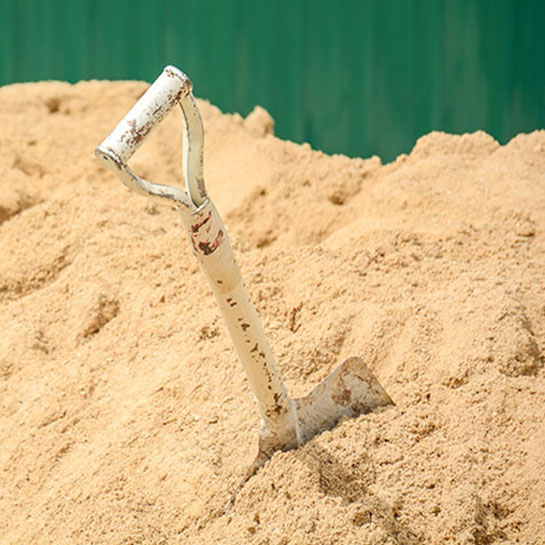If you’ve ever needed to restore a surface, clean facades or prepare something for a new coat of paint, you’ve probably considered using sandblasting. This technique, also known as shot blasting, is decisive in certain tasks because of its ability to prepare the surfaces to which you want to apply a subsequent treatment. However, not just any sand can be used to carry out this process. In this post of ParaTuReforma we explain the requirements that sandblasting sand must meet and how to apply it to achieve quality results.
What is sandblasting sand
This sand is a specific type of abrasive consisting of very fine, dry silica grains. This material is hard and resistant, making it ideal for blasting or sandblasting. It is usually used in the cleaning of surfaces covered by rust or paint, such as walls where graffiti has been painted or those that need to be painted and the old paint has to be removed. It is also used to recover stone facades, brick and other construction materials that have deteriorated for some reason.
What is shot blasting?
Shot blasting is a technique by which silica sand is sprayed onto the silica sand at high speed. For this purpose, specific machinery is used, such as a blasting gun connected to a compressor. The pressure at which the sand is ejected, together with the high hardness and size of the sand, causes the surface layers to detach from the material to which they are attached, leaving the metal or stone free of any kind of residue. Once the work is finished, the surface is ready to implement a treatment, such as varnish or paint, or simply to leave it as it is, if that is the objective.
This technique is aggressive and fast. Therefore, it must be done with care. Protective gloves and goggles must be worn to prevent the sandblasting sand from causing any damage. This technique is also common for maintenance work in hard-to-reach areas, such as recesses and corners where dirt accumulates and where it is difficult to reach by conventional methods.
Types of blasting sand
There are several types of sand for blasting, each with different characteristics. The most commonly used is silica sand, since it is hard enough to remove dirt, paint or rust, among other compounds, and soft enough to maintain the integrity of the surface to be cleaned.

Sand blasting sand requirements and characteristics
For the blasting process to be effective and safe, it is imperative that you choose an appropriate blasting sand. To do this, it must meet several basic requirements. Let’s take a look at the most important ones.
Sand blasting sand grain size
Depending on the type of surface and the work you want to do, the grit can be finer or coarser. The finer sand is ideal for delicate tasks and sensitive surfaces, while the coarser sand is indicated to dispense with more resistant materials. From ParaTuReforma we recommend that you select the sandblasting sand with the appropriate thickness for the type of cleaning you want to do.
Grit size also influences the surface texture after blasting. A finer grit provides a smoother finish, ideal for applications where aesthetics are important, such as metal doors that you are repainting. Coarser grits create a slightly rougher surface, suitable for cases where you claim a stronger adhesion from coatings or paints.
Material purity
The blasting media should be as free as possible from contaminants. If it contains a lot of dust, clay or other materials, its effectiveness is reduced and it generates a lot of particles in suspension during the blasting process. This is not only annoying, but also dangerous. Use the purest sand possible for effective and safe cleaning.
Hardness and durability
Choosing the right hardness allows you to dispose of debris efficiently without fear of it wearing out too quickly. It is also desirable for the sand to have a long service life to reduce unnecessary labor costs.
Safety and regulation
The use of sandblasting sand must comply with health and safety regulations in order to inhibit hazards such as silicosis, a lung disease caused by the recurrent inhalation of silica particles. You must also use the appropriate protective equipment so as not to compromise your safety in the blasting process.
Advantages of sand blasting
Compared to other methods, the use of sandblasting has several benefits in the cleaning and preparation of surfaces. One of the most outstanding is its efficiency and speed, since you can clean large areas in a short period of time and with consistent results. You will get a thorough cleaning that will enhance the adhesion of newly applied paints or new coatings.
At the same time, it is a versatile method, because you can use it on a multitude of materials, from natural stone and brick to metal parts with paint or varnish coatings. And because it is a very effective system, it is more economical in the long run, which is always interesting. The blasting process can be adjusted to suit your specific needs. Simply control variables such as pressure or grit thickness to achieve quality results on every job.
Choose a quality product
If you want to clean and prepare surfaces with optimum results, follow the tips we have provided here and choose blasting sand of the highest purity. By putting this information into practice, you will be able to choose the right type for your specific needs. In our store you will discover different thicknesses of blasting sand at the best price and with fast delivery. Take a look at our online catalog and get what you need to carry out your projects with maximum efficiency.


